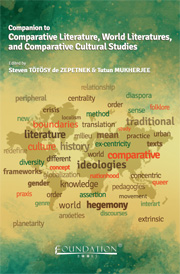Book contents
- Frontmatter
- Contents
- Introduction to the Companion to Comparative Literature, World Literatures, and Comparative Cultural Studies
- PART 1 Theories of Comparative Literature, World Literatures, and Comparative Cultural Studies
- PART 2 Comparative Literature in World Languages
- PART 3 Examples of New Work in Comparative Literature, World Literatures, and Comparative Cultural Studies
- PART 4 Multilingual Bibliography of Books in Comparative Literature, World Literatures, and Comparative Cultural Studies
- Index
Introduction to the Companion to Comparative Literature, World Literatures, and Comparative Cultural Studies
Published online by Cambridge University Press: 05 April 2014
- Frontmatter
- Contents
- Introduction to the Companion to Comparative Literature, World Literatures, and Comparative Cultural Studies
- PART 1 Theories of Comparative Literature, World Literatures, and Comparative Cultural Studies
- PART 2 Comparative Literature in World Languages
- PART 3 Examples of New Work in Comparative Literature, World Literatures, and Comparative Cultural Studies
- PART 4 Multilingual Bibliography of Books in Comparative Literature, World Literatures, and Comparative Cultural Studies
- Index
Summary
To make connections both tangible and virtual is a powerful motivator in scholarship. A tensile filament stretches towards another filament to create the spoke for yet another filament until electronic communication and the world wide web has spread worldwide. This is the figurative environment of knowledge and the transmission of knowledge of our borderless world in the twenty-first century. Linking texts and contexts, cultural products, and the economies of their production, authors, audiences, languages and literacies, politics, and the circulation of power creates the complex texture of interrelated knowledge systems and human relationships that encompass the planet. As Rabindranath Tagore's song goes, “your net spans the world, how can one escape/I'm a half-captive already, the other half eagerly waits,” being trapped within the fluid play of meaning-making, its construction and deconstruction, is the ideal location for negotiating the tangled semantic and cultural interdependence of our time because texts without texture would just be a group of isolated entities, diminished in themselves when unrelated to one another and the world at large. The negotiation of the network of relationships in the rapidly transforming “glocal” milieu requires more than appropriate pedagogies: importantly, it requires a major shift in cultural and aesthetic paradigms and attitudes and a re-orientation towards being more inclusive globally.
- Type
- Chapter
- Information
- Companion to Comparative Literature, World Literatures, and Comparative Cultural Studies , pp. vii - viiiPublisher: Foundation BooksPrint publication year: 2014



